September 4, 2024
Review RecipeKorean BBQ Pork

Table of Contents
Our Korean BBQ pork is a culinary delight, offering an irresistible mix of flavors that will make your dining experience unforgettable. The pork is cooked with crisp onions and smothered in the delicious sauce for a meal that is guaranteed to satisfy.
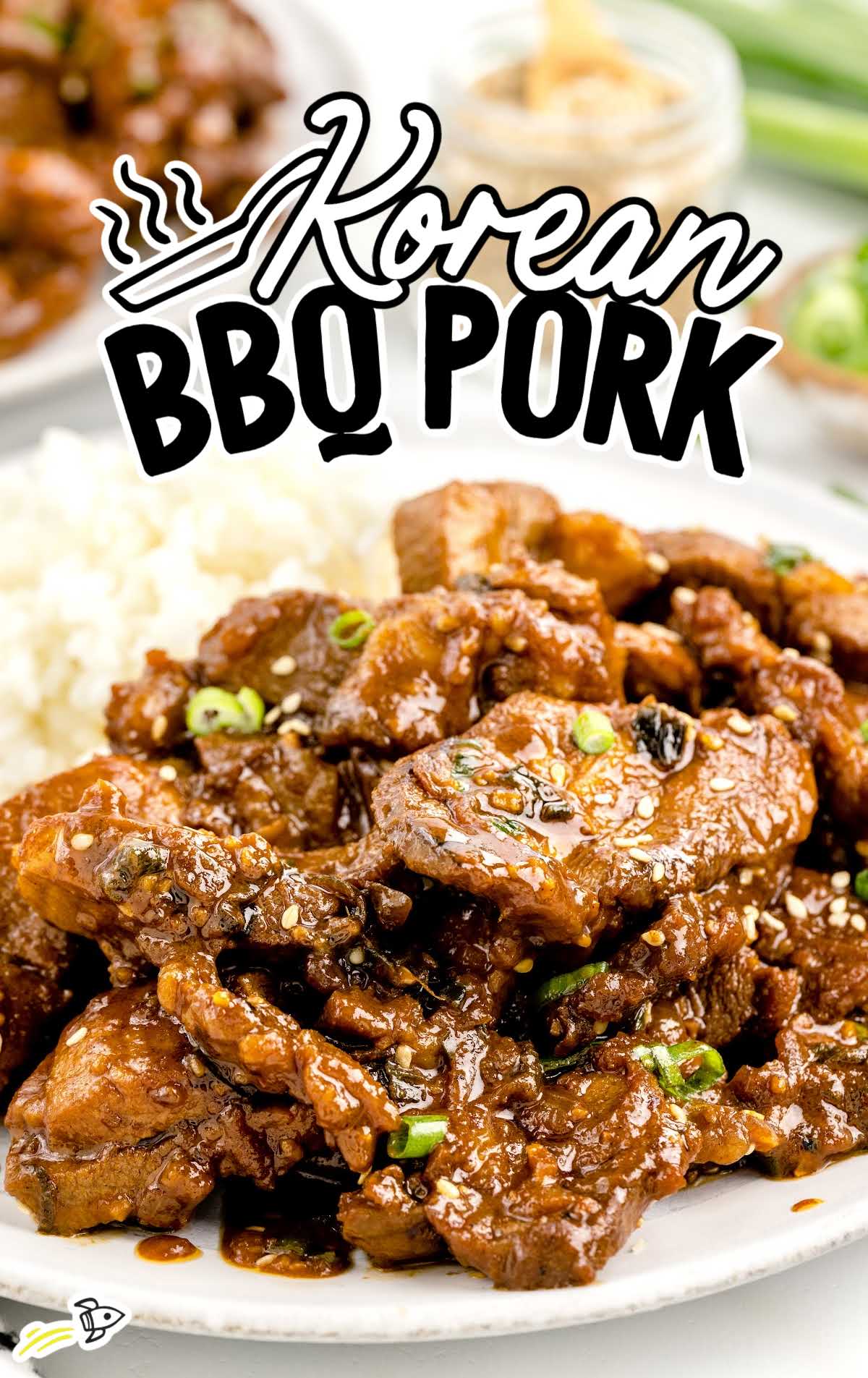
Korean BBQ pork is a dish that’s all about the harmony of flavors. The ingredients work together to create a sauce that makes this dish so irresistible.
The soy sauce is a staple in Korean cuisine, providing a deep umami flavor that forms the base of our marinade.
Gochujang is a fermented chili paste that has a complex flavor profile that gives our Korean BBQ pork its distinctive heat.
The grated apple might seem like an unusual ingredient, but the apple adds a subtle sweetness to the marinade that balances out the heat from the Gochujang.
Korean BBQ Pork Ingredients
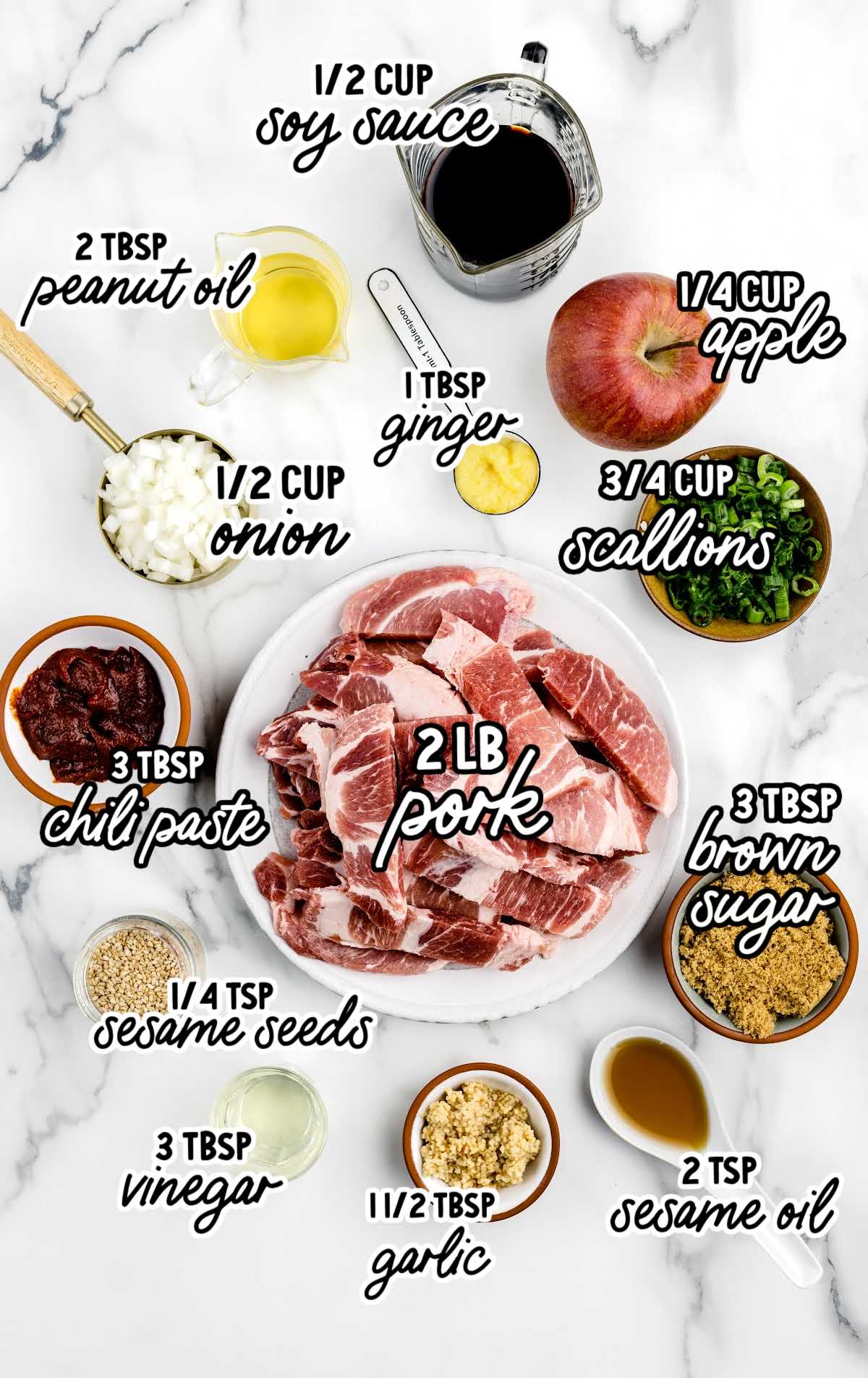
Here’s what you’ll need to make this dish:
- 2 pounds of thinly sliced boneless pork butt
- ½ cup of chopped yellow onion
- ¾ cup of chopped scallions, divided into ½ cup and ¼ cup
- ½ cup of low-sodium soy sauce
- ¼ cup of grated apple (1 small Gala apple peeled and shredded)
- 3 tablespoons of seasoned rice wine vinegar
- 3 tablespoons of Gochujang Korean chili paste
- 3 tablespoons of light brown sugar
- 1½ tablespoons of minced garlic
- 1 tablespoon of grated ginger
- 2 teaspoons of sesame oil
- 2 tablespoons of peanut oil (plus an additional 1 tablespoon if needed for extra cooking batches)
- ¼ teaspoon of sesame seeds (optional garnish)
PRO TIP:
Don’t skip the addition of the Gochujang Korean chili paste. This unique ingredient is very hard to substitute and get a similar flavor profile for your dish.
We found this in the Asian aisle of the local grocery store. You
could also check local Asian markets.
It can be stored in the refrigerator for quite some time and used in many Asian recipes for a more complex sweet heat that a standard hot sauce or chili pepper flakes will not give.
Substitutions And Additions
PORK: If you prefer a different cuts of pork, you can substitute the pork butt with pork belly.
GOCHUJANG KOREAN CHILI PASTE: If you can’t find Gochujang, you can substitute it with a mix of red pepper flakes and a little bit of miso paste.
However, keep in mind that this won’t replicate the unique flavor of Gochujang.
APPLE: When choosing your apple, we like to use a red apple such as Gala, Honeycrisp, or Pink Lady. These apples are easily found at any time of year.
Be sure to peel the apple before grating it.
RICE VINEGAR: Be sure to use seasoned rice wine vinegar in this recipe. It is lightly sweetened, making it different from regular rice vinegar.
You could substitute mirin or dry sherry (be sure to get a good quality that you would drink) in place of the seasoned rice vinegar.
PEANUT OIL: If you have a peanut allergy, you can use grapeseed oil or canola oil instead.
How To Make This Korean BBQ Pork Recipe
With our step-by-step guide, you’ll be able to recreate this flavorful Korean BBQ pork dish with ease.
OUR RECIPE DEVELOPER SAYS
You can freeze your pork butt for two to three hours. This will help firm up the meat to make slicing thin pieces of pork easier.
Be sure to use a really sharp knife, as this cut of pork is fatty and makes it a bit harder to slice.
You do not want to freeze your pork butt solid, as this will make it too hard to slice.
STEP ONE: Add the thinly sliced pork butt, chopped yellow onion, and a half cup of chopped scallions in a large bowl. Set aside.
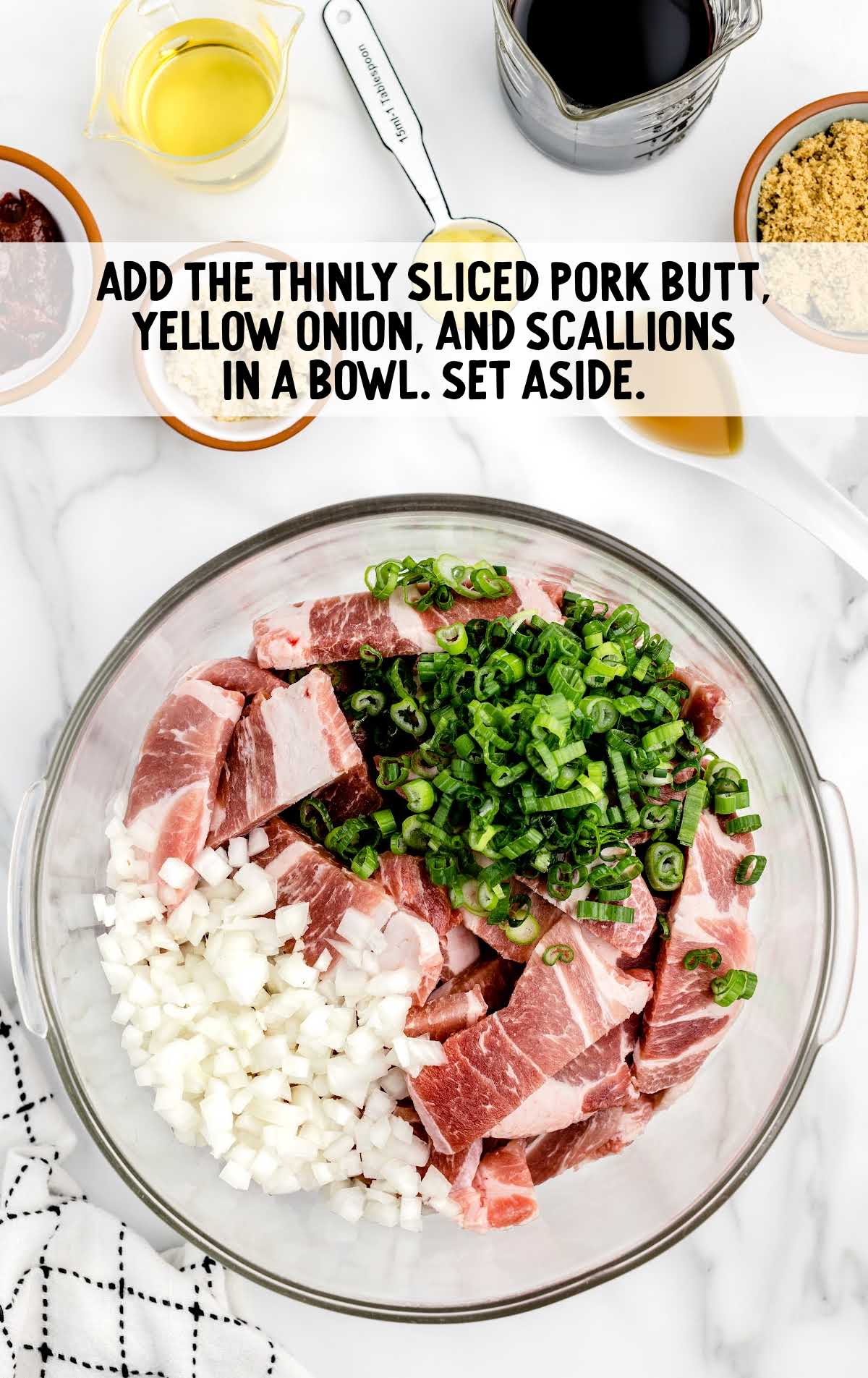
STEP TWO: Make the marinade in a small mixing bowl.
Whisk together the soy sauce, grated apple, seasoned rice wine vinegar, Gochujang Korean chili paste, light brown sugar, minced garlic, grated ginger, and sesame oil.
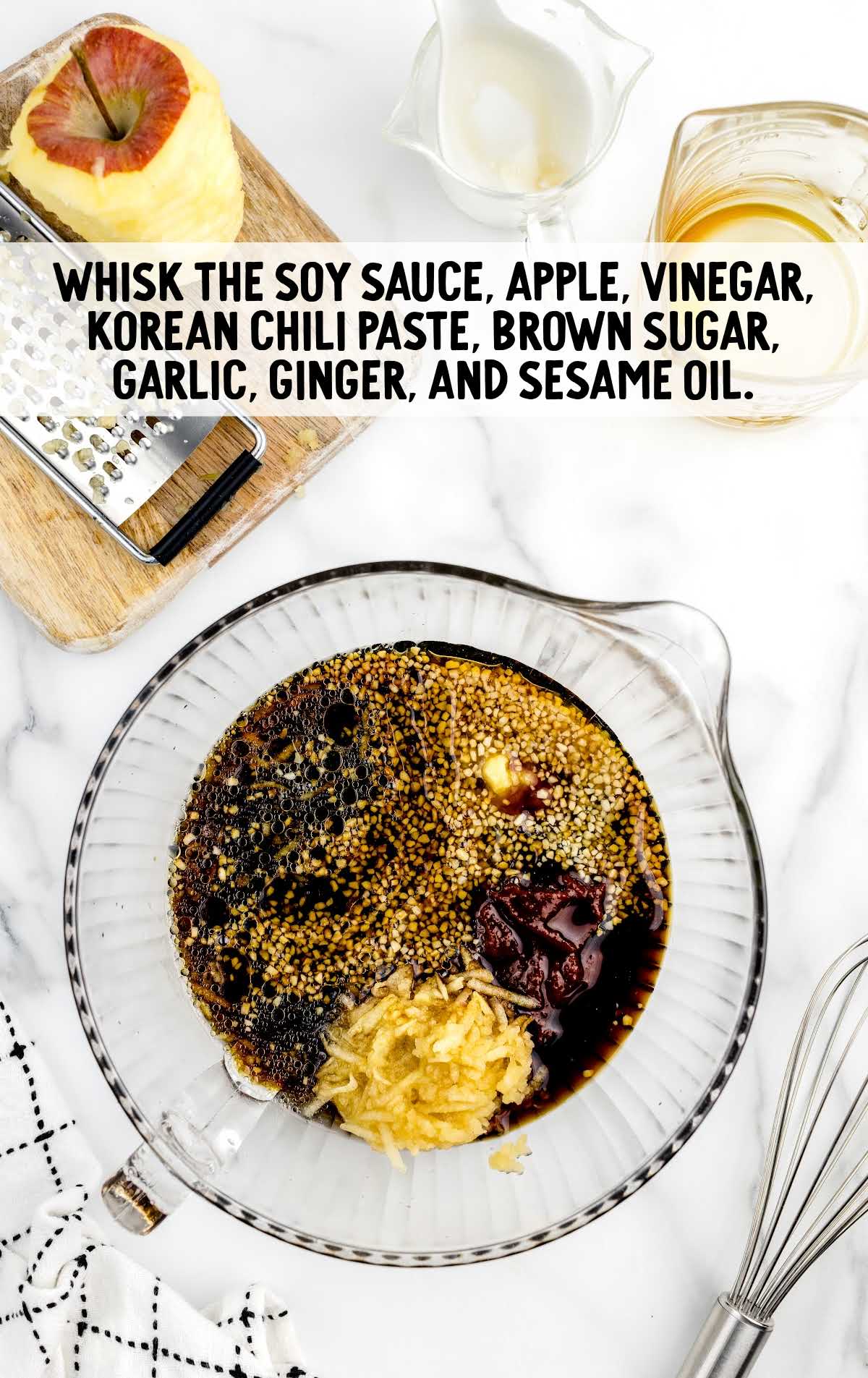
STEP THREE: Pour the marinade into the bowl of the pork slices and onions. Stir to fully coat all the pork with the marinade.
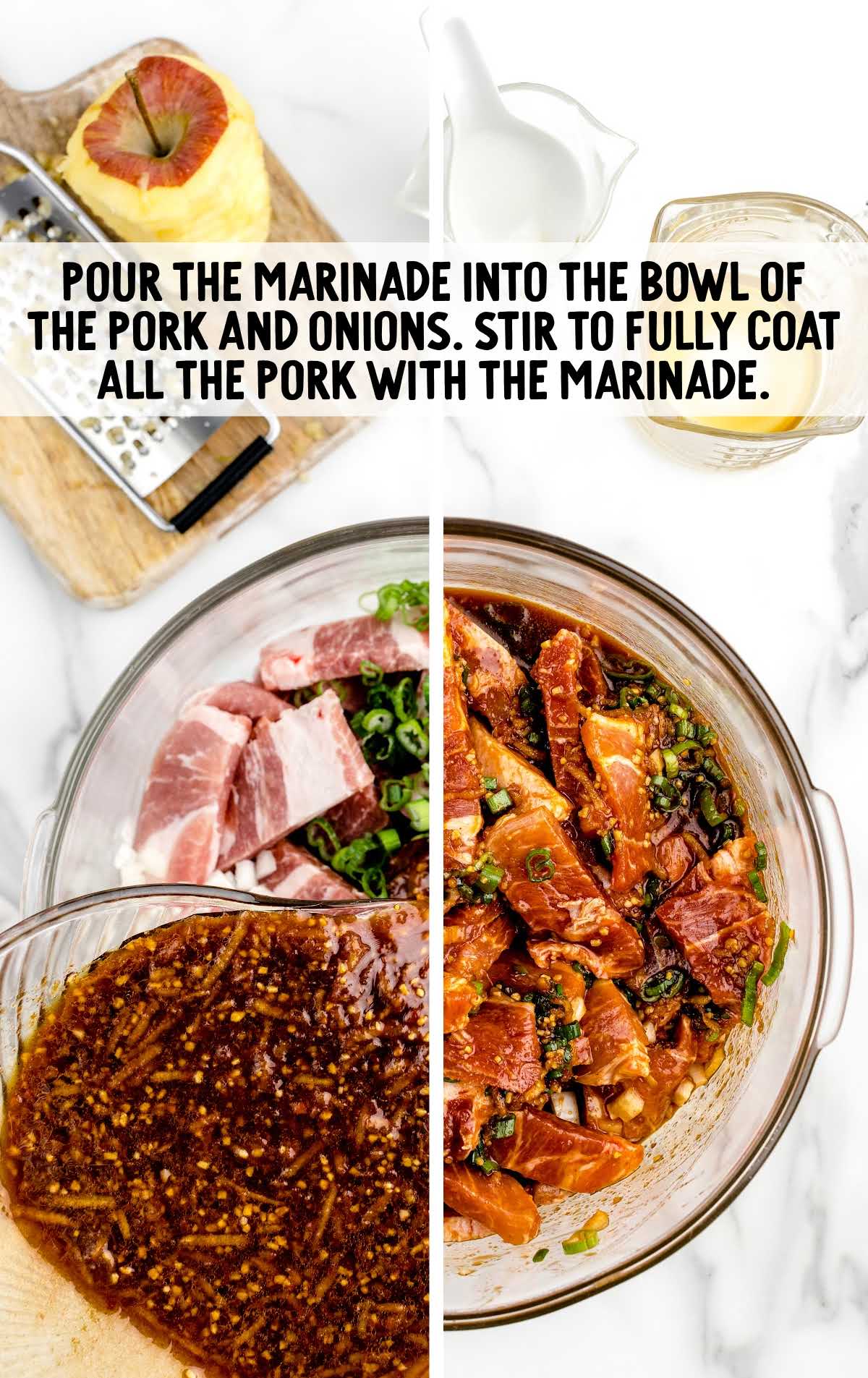
STEP FOUR: Cover the bowl with plastic wrap and refrigerate for one hour or up to overnight to allow the pork to marinate and absorb the flavors.
PRO TIP:
If marinating the pork for more than two hours (or up to overnight), you will want to allow the bowl of marinated pork to sit on the counter for 20-30 minutes to allow the pork to come to room temperature. This will let the pork cook more evenly.
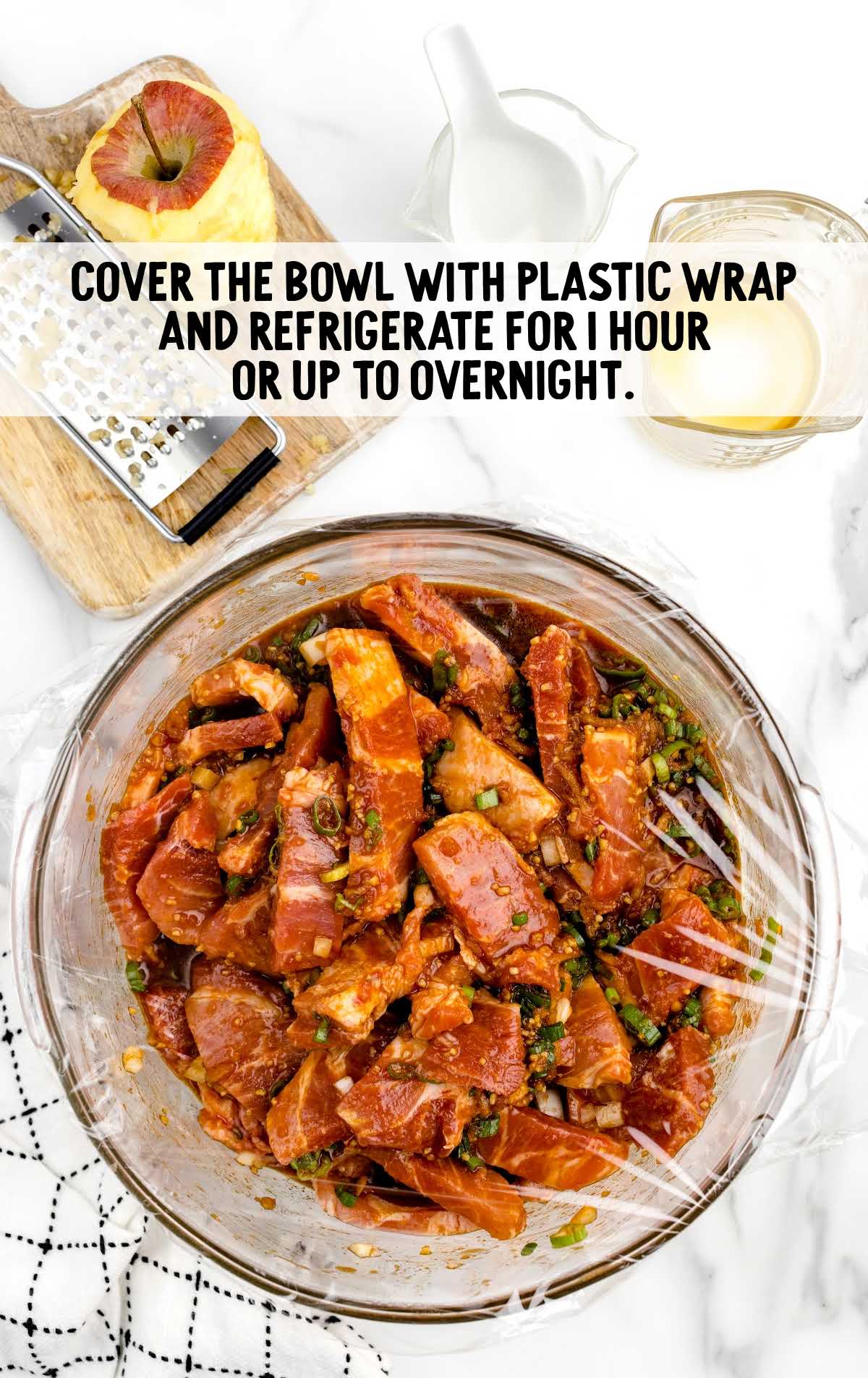
STEP FIVE: Add the peanut oil to a large, heavy-duty skillet on high heat. Once the oil is very hot, add half the marinated pork.
Cook for four to six minutes. Remove the cooked pork to a serving plate and set aside.

STEP SIX: Add the remaining marinated pork to the skillet. You can add an additional one tablespoon of peanut oil if needed.
Cook for another four to six minutes or until the pork is cooked through and the marinade thickens into a glaze.
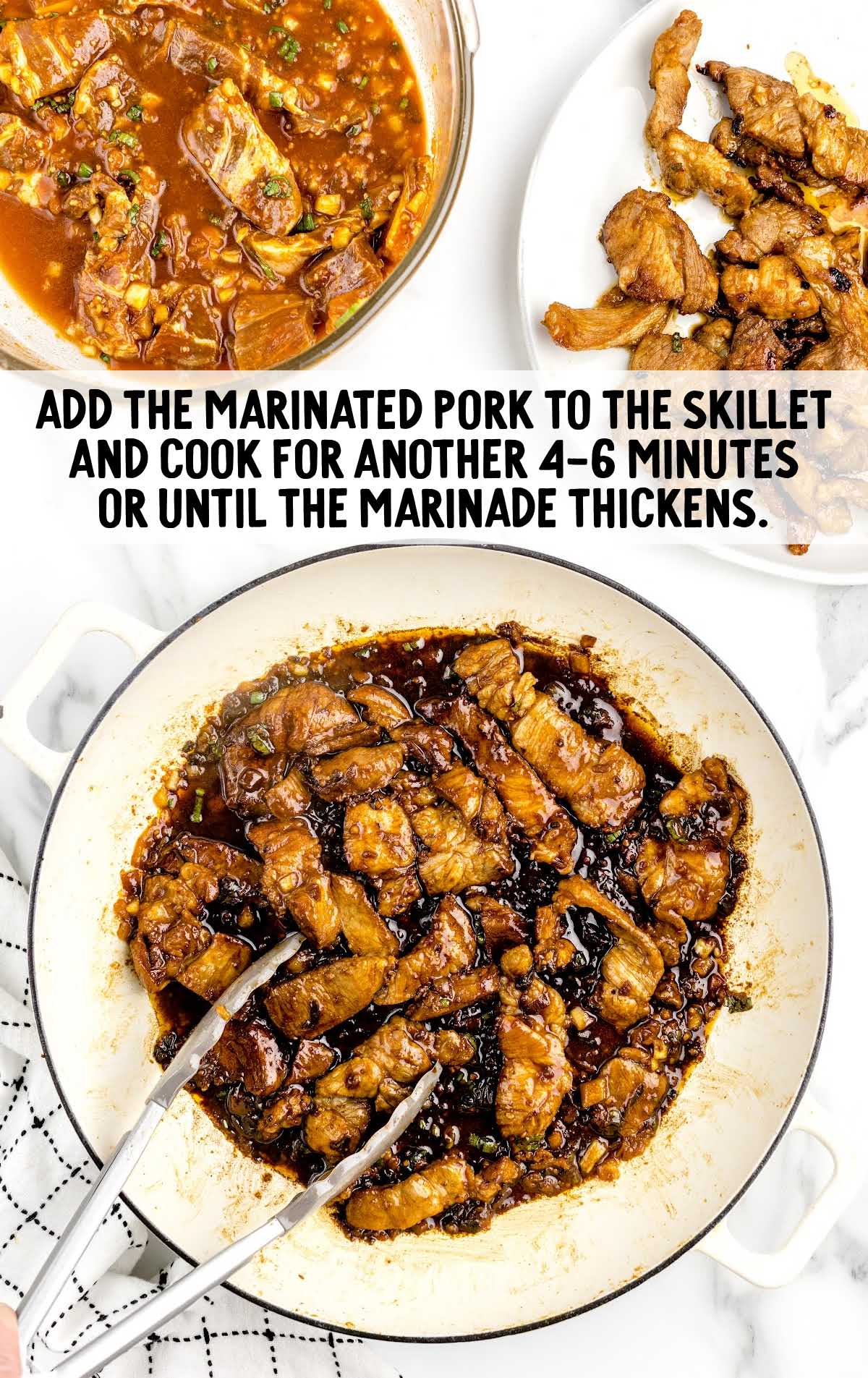
STEP SEVEN: Add the second batch of cooked Korean BBQ pork to the serving plate.
Garnish with the remaining quarter cup of chopped green onion and optional sesame seeds.
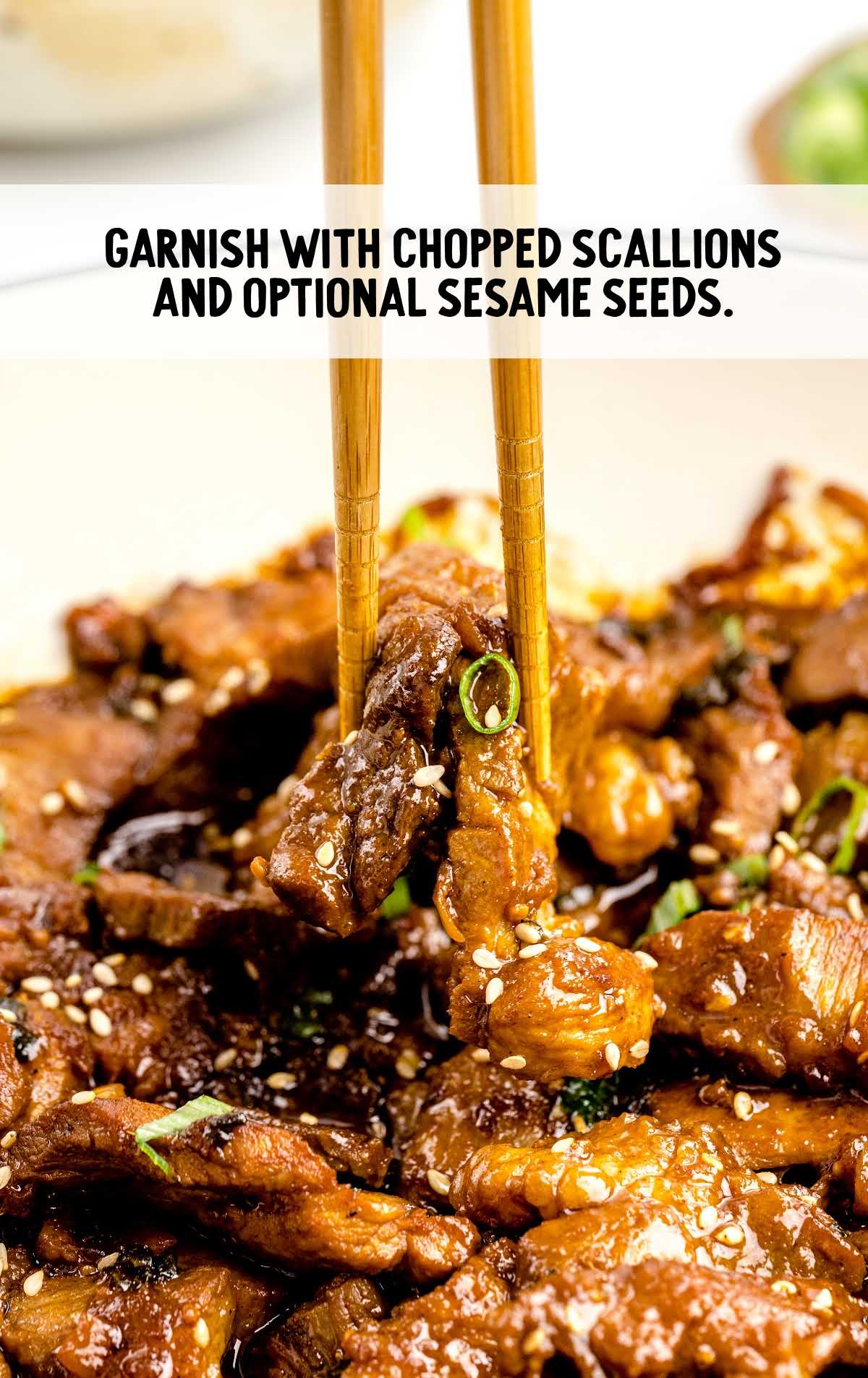
How To Serve
This dish pairs beautifully with a side of prepared white rice. We recommend using jasmine rice for its fragrant aroma and slightly sticky texture.
You can also serve the Korean BBQ pork in lettuce wraps. The crisp, fresh lettuce complements the rich, spicy pork perfectly.
For an authentic Korean dining experience, serve the BBQ pork with a side of kimchi. The tangy, fermented cabbage adds a refreshing contrast to the rich pork.
For a fusion twist, use Korean BBQ pork as a filling for tacos. Top with coleslaw made from cabbage, carrots, and a tangy vinaigrette for a delicious Korean-Mexican mashup.
To transform your leftover Korean BBQ Pork into mouthwatering pork sandwiches, simply toast some buns until they’re lightly crisp. Layer the buns with a generous amount of the juicy, flavorful pork. Add a layer of tangy kimchi for a delightful crunch and a burst of flavor that complements the smoky BBQ taste.
For two more Korean recipes that bring so much flavor to the table, our Korean chicken and Korean beef are worth checking out.
MORE PORK RECIPES
Storage
Our Korean BBQ pork is best enjoyed fresh, but if you have leftovers, here’s how to store them:
MAKE AHEAD: This recipe is excellent for meal prep. You can marinate the pork ahead of time and store it in the refrigerator.
When you’re ready to cook, just heat up your skillet, and you’re good to go.
IN THE FRIDGE: Leftovers can be stored in an airtight container in the refrigerator for up to three days. Be sure to let the pork cool completely before storing it.
IN THE FREEZER: If you want to freeze the marinated pork, place it in a freezer-safe heavy-duty zip-top bag, remove the excess air, and freeze for up to one month.
Thaw completely in the refrigerator before cooking.
REHEATING: To reheat the pork, you can warm it up in a large skillet over medium heat.
If you’re in a hurry, you can also use the microwave. Just be sure to cover the dish to prevent the pork from drying out.
Why We Love This Recipe
There are so many reasons to love this Korean BBQ pork recipe, but here are a few of our favorites:
GREAT FLAVOR: This dish is a flavor powerhouse. The marinade is a perfect balance of sweet and savory flavors with a spicy kick, infusing the pork with a depth of flavor that’s hard to resist.
VERSATILITY: This recipe is incredibly versatile. You can serve it with rice, use it as a filling for tacos, or even top your bibimbap with it.
EASE: Despite its complex flavors, this recipe is surprisingly easy to make. The marinade does most of the work for you, and the cooking process is straightforward and quick, making it perfect for a weeknight dinner.
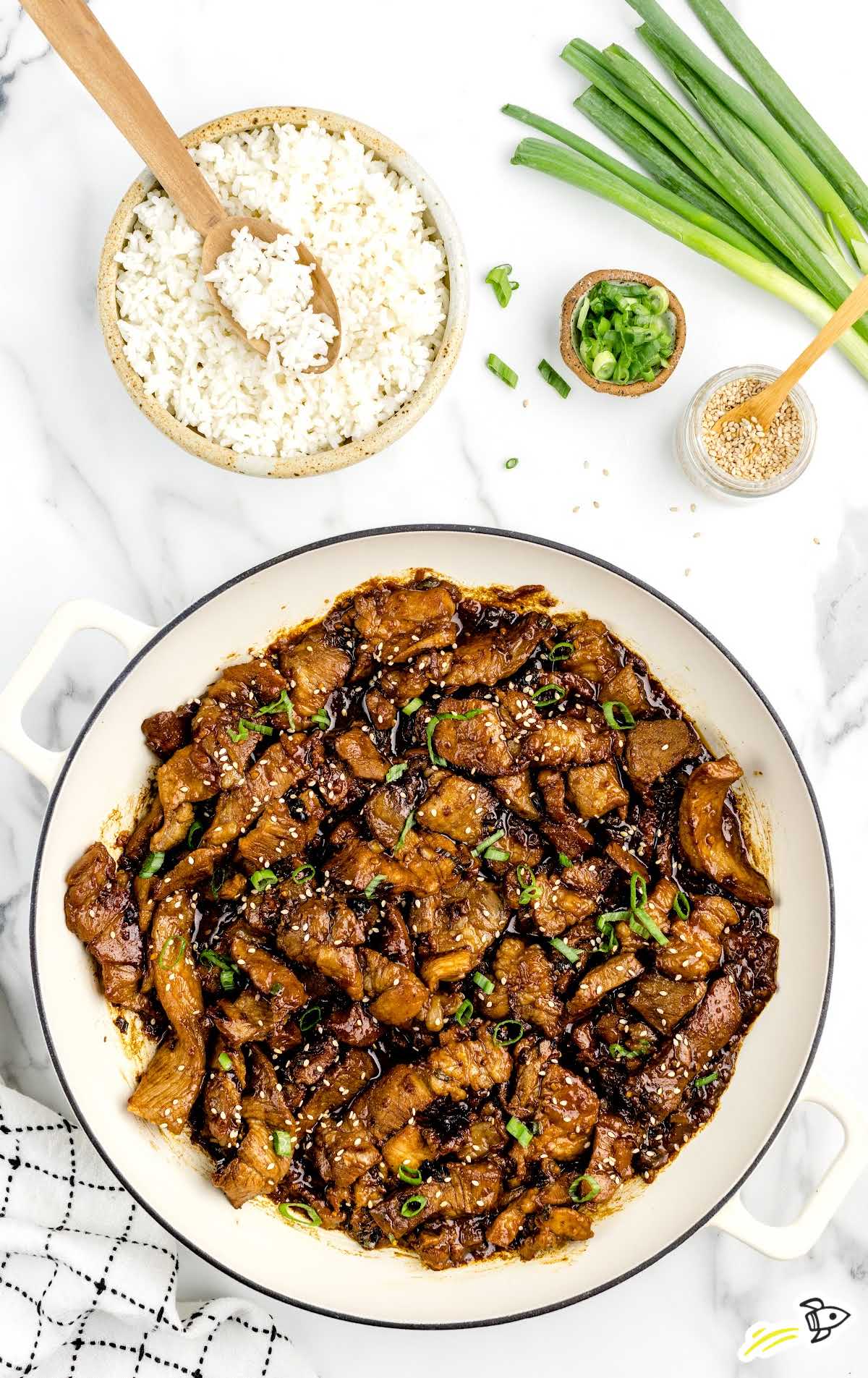
Our Korean BBQ pork is a satisfying dish that’s sure to impress. Its unique combination of tangy umami flavors, along with a bit of sweetness, coupled with its ease of preparation, makes it a recipe you’ll find yourself coming back to time and again.
Koreen BBQ Pork Frequently Asked Questions
You can substitute the pork butt with pork belly or even ribeye steak for a beef version of this dish.
We do not recommend freezing the cooked pork as it may affect the texture. However, you can freeze the marinated pork in a freezer-safe heavy-duty zip-top bag for up to one month.
Leftovers can be stored in an airtight container in the refrigerator for up to three days.
You can marinate the pork ahead of time and store it in the refrigerator. When you’re ready to cook, just heat up your skillet, and you’re good to go.
If you can’t find Gochujang, you can substitute it with a mix of red pepper flakes and a little bit of miso paste. However, keep in mind that this won’t replicate the unique flavor of Gochujang.
More Recipes You’ll Love
- Korean Noodles
- The Best Recipe For Bang Bang Chicken
- Beef Ramen Stir Fry
- Homemade Mongolian Beef
- Crockpot Ranch Pork Chops
- Homemade Egg Rolls
- Slow Cooker Brisket

Korean BBQ Pork
Ingredients
- 2 pounds boneless pork butt, thinly sliced
- ½ cup chopped yellow onion
- ¾ cup chopped scallions, divided into ½ cup and ¼ cup
- ½ cup low-sodium soy sauce
- ¼ cup grated apple, 1 small gala apple peeled and shredded
- 3 tablespoons seasoned rice wine vinegar
- 3 tablespoons Gochujang Korean chili paste
- 3 tablespoons light brown sugar
- 1½ tablespoons minced garlic
- 1 tablespoon grated ginger
- 2 teaspoons sesame oil
- 2 tablespoons peanut oil, plus an additional 1 tablespoon if needed for extra cooking batches
- ¼ teaspoon sesame seeds, optional garnish
Instructions
- Add the thinly sliced pork butt, chopped yellow onion, and ½ cup chopped scallions in a large bowl. Set aside.
- Make the marinade in a small mixing bowl by whisking together the soy sauce, grated apple, seasoned rice wine vinegar, Gochujang Korean chili paste, light brown sugar, minced garlic, grated ginger, and sesame oil.
- Pour the marinade into the bowl of the pork and onions. Stir to fully coat all the pork with the marinade.
- Cover the bowl with plastic wrap and refrigerate for 1 hour or up to overnight to allow the pork to marinate and absorb the flavors.
- Add the peanut oil to a large, heavy-duty skillet on high heat. Once the oil is very hot, add half the marinated pork. Cook for 4-6 minutes. Remove the cooked pork to a serving plate and set aside.
- Add the remaining marinated pork to the skillet (add an additional 1 tablespoon of peanut oil if needed) and cook for another 4-6 minutes or until the pork is cooked through and the marinade thickens into a glaze.
- Add the second batch of cooked Korean BBQ pork to the serving plate and garnish with the remaining ¼ cup of chopped scallions and optional sesame seeds.
Notes
- Please don’t skip the addition of the Gochujang Korean chili paste. This unique ingredient is very hard to substitute and get a similar flavor profile for your dish. I found this in the Asian aisle of my local grocery store. You can store it in the refrigerator for quite some time and use it in many Asian recipes for a more complex sweet heat that a standard hot sauce or red pepper flakes will not give.
- Freezing your pork butt for 2-3 hours will help firm up the meat to make slicing it into thin slices easier. Be sure to use a really sharp knife, as this cut of pork is fatty and makes it a bit harder to slice. You do not want to freeze your pork butt solid, as this will make it too hard to slice.
- If marinating the pork for more than 2 hours (or up to overnight), you will want to allow the bowl of marinated pork to sit on the counter for 20-30 minutes to allow the pork to come to room temperature. This will let the pork cook more evenly.
Nutrition
Even More Recipes You’ll Love
- Pork Tenderloin
- Pork Fried Rice
- Instant Pot Pulled Pork
- Fireball BBQ Sauce
- Sheet Pan Tacos
- Red Beans and Rice
- Better Than Take Out Fried Rice
- Sheet Pan Stir Fry
- Pepper Steak
- Beef Quesadilla Recipe
- Puffy Tacos
- 3 Ingredient Satay Sauce
- Teriyaki Steak Bites
- Shrimp Tacos
- Asian Steak Bites
- Crock Pot Cube Steak
- Unstuffed Cabbage Rolls
- French Onion Beef
- Carolina Gold BBQ Sauce


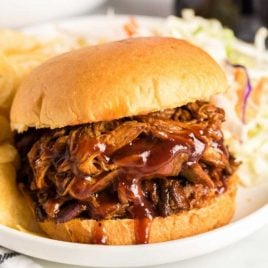
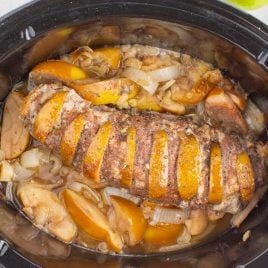











Leave a Comment